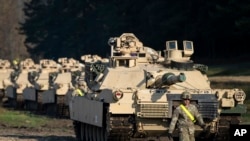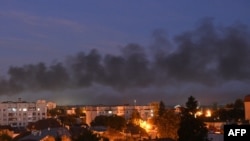Ukraine said Wednesday a Russian drone attack overnight damaged an oil refinery in the Poltava region in the central part of the country.
Governor Dmytro Lunin said operations at the plant were temporarily suspended, and that there were no reports of casualties.
Serhiy Lysak, the regional governor of Dnipropetrovsk, said Russia attacked Nikopol and three other areas, damaging five houses.
Ukraine’s military said its air defenses shot down 17 of 24 drones that Russia used in its overnight attacks.
US tanks
Ukraine’s efforts to break through Russia’s defensive lines could soon benefit from some long-awaited firepower — some 31 U.S.-made M1 Abrams tanks first promised in January.
U.S. Defense Secretary Lloyd Austin announced the impending delivery of the U.S. tanks Tuesday during a meeting of some 50 nations in the U.S.-led Ukraine Defense Contact Group in Germany on Tuesday, noting the coalition “continues to move heaven and earth to get Ukraine what it needs right now.”
“That will add another formidable armor capability to join the [German-made Leopard tanks] that are already on the battlefield,” he added.
Speaking separately, a defense official told reporters traveling with the secretary that the U.S. tanks are already in Europe and will begin crossing into Ukraine in the coming days.
Ukrainian forces began training on the M1 Abrams tanks in June.
And U.S. military officials told VOA earlier this month that about 200 Ukrainian soldiers were continuing to train in Germany to maintain proficiency until the tanks are ready for delivery.
U.S. defense officials had previously said the M1 Abrams tanks would be delivered by the fall.
Ammunition
In addition to the tanks, the U.S. has also been providing Ukraine with depleted uranium ammunition for the M1 Abrams — armor-piercing rounds that were designed to destroy Soviet-made tanks, like the ones Russia has deployed to the front lines in Ukraine.
And perhaps just as importantly, U.S. defense officials say they have mechanisms in place to help Ukraine keep the tanks on the battlefield.
“We've built a much more fulsome sustainment structure to hand over to the Ukrainians,” said Douglas Bush, the U.S. Army’s acting assistant secretary for acquisition, logistics and technology.
“We've done all we can do to set conditions for the support structure in Europe to where we will be able to flow them repair parts and then help them with battle damage repair and things like that,” Bush told reporters Tuesday, speaking from the Pentagon. “They're getting … a lot more spare parts.”
Bush also sought to downplay concerns about maintaining the M1 Abrams tanks, viewed as one of the more complicated capabilities shared so far with Ukraine’s military.
“The Ukrainians have been remarkably adept at maintaining Strykers and Bradleys [armored vehicle platforms], for example, via telemaintenance and indirect support from us,” he said. “So, we’re hopeful.”
Other Western officials, including U.S. General Mark Milley, chairman of the Joint Chiefs of Staff, also found reason for hope, despite the relatively slow pace of Ukraine’s ongoing counteroffensive.
“Ukraine continues to make deliberate, steady progress in liberating their homeland from Russian occupation,” Milley said, speaking alongside Austin during a news conference at Ramstein Air Base in Germany.
“To date, Ukraine has liberated over 54% of Russian-occupied Ukraine, and they continue to retain the strategic initiative,” he said.
Russian troops
Milley said Russia still has about 200,000 to 300,000 troops in Ukraine and that many of them “are not extraordinarily well-trained.” He warned that the effort to eject them from Ukrainian territory remains a “tough fight, a hard fight,” but said the Ukrainian military is up for the task, even if it means fighting into the winter months.
“Russia has made one of the greatest strategic errors Russia's ever made,” Milley said. “They've invaded a country that's been free and independent, and that country's not going to quit until they, too, are free and independent once again.”
NATO’s top official, likewise, touted Ukraine’s chances.
“It is not a stalemate,” NATO Secretary-General Jens Stoltenberg told Reuters on the sidelines of the United Nations General Assembly in New York.
“The Ukrainians are gaining ground,” he said. “They have gained, pushed back the Russians again and again, and they are continuing to gain ground in the south and east.”
In addition to the imminent delivery of the U.S.-made M1 Abrams tanks to Ukraine, the U.S. and its allies are set to begin training Ukrainian fighter pilots on U.S.-made F-16 fighter jets that will be donated by the Netherlands, Denmark and Norway.
But there was no talk Tuesday of providing Ukraine with longer-range missiles that Ukrainian officials have been asking for.
Ukrainian President Volodymyr Zelenskyy and other top officials have repeatedly asked for missiles capable of striking key targets behind Russia’s front lines, such as the U.S.-made Army Tactical Missile System, known as ATACMS that can fly up to 306 kilometers.
U.S. officials, speaking on the condition of anonymity, have said Washington is now actively considering the request. But so far, the White House has balked at giving Ukraine weapons that could be used to strike beyond Ukraine’s legal borders and into Russian territory.
US government shutdown
In addition to some U.S. reticence to provide certain weapons systems, aid to Ukraine could also soon be hampered by a potential U.S. government shutdown.
Pentagon spokesperson Chris Sherwood said in a statement Tuesday, first reported by Politico, that delivery of security assistance to Ukraine "could be impacted by furloughs of personnel and DoD's suspension" of nonessential activities.
Additionally, Mira Resnick, the State Department’s deputy assistant secretary for regional security, told lawmakers Tuesday that during past government shutdowns, the U.S has been unable to process new licenses or new military sales except in an emergency.
Congress has until October 1 to enact at least short-term spending bills to avoid a partial government shutdown.
Attacks on Lviv
Ukrainian officials said Tuesday that Russian aerial attacks hit the western Ukrainian city of Lviv, killing one person.
Lviv Mayor Andriy Sadovyi said on Telegram the attack struck three warehouses, which stored windows, household chemicals and humanitarian aid.
U.N. humanitarian coordinator for Ukraine Denise Brown condemned the Russian strike, saying one of the warehouses belonged to Caritas, the Vatican’s main charitable organization.
“The vital humanitarian facility, which contained approximately 300 tons of relief supplies, was burned to the ground,” Brown said in a statement. “Attacks impacting humanitarian assets have escalated throughout the year and ultimately impact those who are suffering the horrific consequences of the war.”
Lviv, located near Ukraine’s border with Poland, is a key hub for Western aid entering Ukraine and has been the target of prior Russian attacks.
Ukraine’s military said air defenses destroyed 27 of 30 drones that Russia used in its attacks, with intercepts happening in southern, central and western Ukraine.
The military also said it downed a Russian reconnaissance drone in the eastern part of the country.
Some information for this report came from The Associated Press, Reuters and Agence France-Presse.











